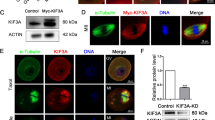Abstract
We have investigated factors which determine inequality of the first two cleavages in Tubifex hattai. A mitotic spindle for the first cleavage, which is located at the center of the egg, possesses an aster at one pole, but not at the other pole. Inequality of the first cleavage is determined by the asymmetric organization of the spindle poles, rather than by the spindle position in the egg. A centrosome which appears as a dot stained with an anti-γ-tubulin antibody is found at one pole (at the center of the aster) of the spindle, but not at the other pole. This centrosome appears to be maternal in origin. In contrast to the first cleavage, the poles of the second cleavage spindle are not different from each other either in their ability to form asters or in γ-tubulin distribution. As a result of an interaction of one of the spindle poles with the cell cortex, however, an asymmetric spindle is formed in the cell CD, giving rise to unequal division in this cell. Thus, factors generating asymmetry in spindle organization are intrinsic to the mitotic spindle in the first cleavage, but not in the second cleavage.
Similar content being viewed by others
References
Braidotti, P. & M. Ferraguti, 1982. Two sperm types in the spermatozeugmata of Tubifex tubifex (Annelida, Oligochaeta). J. Morph. 171: 123–136.
Dan, K. & S. Ito, 1984. Studies on unequal cleavages in molluscs: I. Nuclear behavior and anchorage of a spindle pole to cortex as revealed by isolation technique. Dev. Growth & Differ. 26: 249–262.
Freeman, G. & J. W. Lundelius, 1992. Evolutionary implications of the mode of D quadrant specification in coelomates with spiral cleavage. J. evol. Biol. 5: 205–247.
Gathy, E., 1900. Contribution à l'étude du développement de l'oeuf et de la fécondation chez les annelides. Cellule 17: 7–62.
Hirao, Y., 1965. Cocoon formation in Tubifex with its relation to the activity of the clitellar epithelium. J. Fac. Sci. Hokkaido Univ. Ser VI, Zool. 15: 625–632.
Huber, W., 1946. Der normale Formwechsel des Mitoseapparates und der Zellrinde beim Ei von Tubifex. Rev. suisse Zool. 53: 468–474.
Hyman, A. A., 1989. Centrosome movement in the early divisions of Caenorhabditis elegans, a cortical site determining centrosome position. J. Cell Biol. 109: 1185–1193.
Inase, M., 1960. On the double embryo of the aquatic worm Tubifex hattai. Sci. Rep. Tohoku Univ. Ser. IV, Biol. 26: 59–64.
Ishii, R. & T. Shimizu, 1995. Unequal first cleavage in the Tubifex egg: involvement of a monastral mitotic apparatus. Dev. Growth & Differ. 37: 687–701.
Lehmann, F. E., 1946. Mitoseablauf und Bewegungsvorgänge der Zellrinde bei zentrifugierten Keimen von Tubifex. Rev. suisse Zool. 53: 475–480.
Lehmann, F. E., 1956. Plasmatische Eiorganisation und Entwicklungsleistung beim Keim vom Tubifex (Spiralia). Naturwissenschaften 43: 289–296.
Mabuchi, I., 1986. Biochemical aspects of cytokinesis. Int. Rev. Cytol. 101: 175–213.
McIntosh, J. R. & M. E. Porter, 1989. Enzymes for microtubule-dependent motility. J. biol. Chem. 264: 6001–6004.
Penners, A., 1922. Die Furchung von Tubifex rivulorum Lam. Zool. Jb. Abt. Anat. Ontog. 43: 323–367.
Penners, A., 1924. Experimentalle Untersuchungen zum Determinationsproblem an Keim vom Tubifex rivulorum Lam. I. Die Duplicitas cruciata and Organbildende Keimbezirke. Arch. Mikrosk. Abt. Entwick. Mechan. 101: 51–100.
Rappaport, R., 1986. Establishment of the mechanism of cytokinesis in animal cells. Int. Rev. Cytol. 105: 245–281.
Schroeder, T. E., 1987. Fourth cleavage of sea urchin blastomeres: microtubule patterns and myosin localization in equal and unequal cell divisions. Dev. Biol. 124: 9–22.
Shimizu, T., 1982a. Development in the freshwater oligochaete Tubifex. In F. W. Harrison & R. R. Cowden (eds), Developmental Biology of Freshwater Invertebrates. A. R. Liss, New York: 283–316.
Shimizu, T., 1982b. Ooplasmic segregation in the Tubifex egg: mode of pole plasm accumulation and possible involvement of microfilaments. Roux's Arch. dev. Biol. 191: 246–256.
Shimizu, T., 1984. Dynamics of the actin microfilament system in the Tubifex egg during ooplasmic segregation. Dev. Biol. 106: 414–426.
Shimizu, T., 1986. Bipolar segregation of mitochondria, actin networks, and surface in the Tubifex egg: role of cortical polarity. Dev. Biol. 116: 241–251.
Shimizu, T., 1988. Localization of actin networks during early development of Tubifex embryos. Dev. Biol. 125: 321–331.
Shimizu, T., 1989. Asymmetric segregation and polarized redistribution of pole plasm during early cleavages in the Tubifex embryo: role of actin networks and mitotic apparatus. Dev. Growth & Differ. 31: 283–297.
Shimizu, T., 1993. Cleavage asynchrony in the Tubifex embryo: involvement of cytoplasmic and nucleus-associated factors. Dev. Biol. 157: 191–204.
Shimizu, T., 1994. The prevention of smaller blastomeres of early Tubifex embryos from entering mitosis by unreplicated DNA. Dev. Biol. 161: 274–284.
Shimizu, T., 1995. Lineage-specific alteration in cell cycle structure in early Tubifex embryos. Dev. Growth & Differ. 37: 263–272.
Shimizu, T., 1996. Behaviour of centrosomes in early Tubifex embryos: asymmetric segregation and mitotic cycle-dependent duplication. Roux's Arch. dev. Biol. 205: 290–299.
Sluder, G., 1992. Control of centrosome inheritance in echinoderm development. In V. I. Kalnins (ed), The Centrosome. Academic Press, San Diego: 235–259.
Symes, K. & D. A. Weisblat, 1992. An investigation of the specification of unequal cleavages in leech embryos. Dev. Biol. 150: 203–218.
Woker, H., 1944. Die Wirkung des Colchicins auf Furchungsmitosen und Entwicklungsleistungen des Tubifex-Eies. Rev. suisse Zool. 51: 109–170.
Author information
Authors and Affiliations
Rights and permissions
About this article
Cite this article
Shimizu, T. The first two cleavages in Tubifex involve distinct mechanisms to generate asymmetry in mitotic apparatus. Hydrobiologia 334, 269–276 (1996). https://doi.org/10.1007/BF00017377
Issue Date:
DOI: https://doi.org/10.1007/BF00017377




